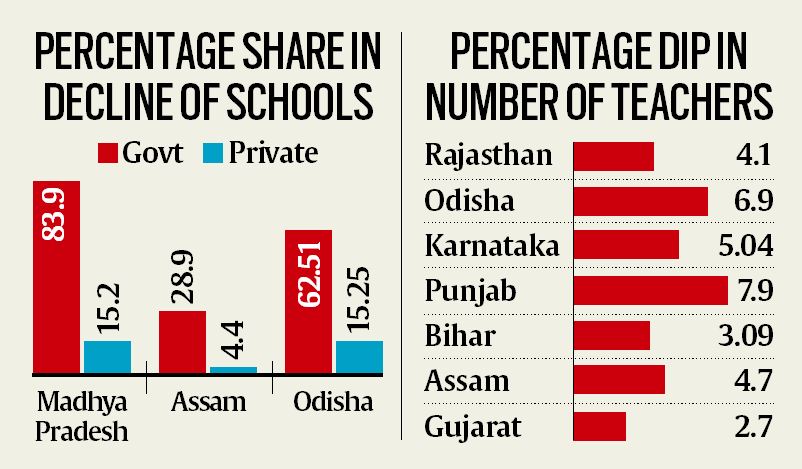Pandemic effect: Dip in number of schools, surge in teacher exits
The second wave of Covid-19 hit India’s school education with over 20,000 schools — just over 1 per cent of the total number — shutting down and close to 1.89 lakh teachers — almost two per cent of their total — exiting the work force. That’s not all. Reflecting economic distress, there was an almost two-fold rise in the transfer of students from private to government schools as compared to the first year of the pandemic, shows the Unified District Information System for Education Plus (UDISE+) data for the year 2021-22.
Schools were hit during the first wave of Covid-19 as well but the crisis exacerbated after the Delta variant, show a comparative analysis of the latest UDISE+ report with the previous ones.
The drop in the number of schools, from 15.09 lakh in 2020-21 to 14.89 lakh in 2021-22, is significant given that this is the second dip in school count since UDISE counting came to be managed by the Department of School Education and Literacy in 2018-19. Among schools that shut down, the share of private schools was 24% and government schools were 48%, with government-aided schools and “others” making up the rest.
The report shows that the trend of students shifting from private to government schools also deepened during the last financial year, showing the economic cost of the pandemic marked by job losses and pay cuts. The period saw enrollment in govt schools increase by 83.35 lakh while in private schools it dipped by 68.85 lakh.
“The decline in total schools is mainly due to closure of schools under private and other management,” the ministry of education said in a statement, also identifying “grouping/clustering of schools by various states” as another factor behind the decline. The report, however, did not go into the possible factors behind the fall in the number of teachers and the worsening of other indicators such as drop-out rates.


Separate data on merged schools was not immediately available. Also, Madhya Pradesh alone accounts for a drop of 6,457 government schools (66.82% of the total drop in government schools) and 1,167 private schools, almost 24% of the total private schools shut. These are the highest for any state or UT.
Past UDISE reports show that the last drop was between 2018-19 and 2019-20, when it came down by 43,292 (2.79 per cent). But that drop was driven primarily by the merger of government schools as the number of private schools had risen by 11,271 during the same period.
Across UTs and states, except Uttar Pradesh, West Bengal, Telangana and Goa, there were less teachers in 2021-22 than 2020-21. Between 2019-20 and 202–21, the category of teachers recorded a rise of 8848, while the number of schools had increased by 1428.
In the latest round, Rajasthan, where as many as 1197 private schools shut down and there were 31,148 less teachers than the previous year, was among the worst-hit. The number of government schools in the state was down by 135.
Odisha, where the number of schools dropped by 1984 including 289 run privately, there was a reduction of 24,638 teachers, followed by Karnataka (22937), Punjab (21940), Bihar (18643), Assam (17397) and Gujarat (10687). There was a drop in teacher numbers even in states where not many schools have shut.
For instance, in Bihar the number of government and private schools rose by 3 and 174 respectively. However, the number of teachers in the state dropped by 18,643, which indicates that many schools that managed to stay afloat curtailed staff strength substantially as the pandemic showed no signs of abating, leading to prolonged school closures.
The UDISE+ report, released by the Ministry of Education, observed that although the impact of the COVID-19 pandemic is cross-cutting, “this is particularly noticed in the enrolment of young and vulnerable kids like pre-primary classes may be attributed to postponement of admissions due to COVID-19.”
The enrollment in pre-primary sections (excluding anganwadis run by the Ministry of Women and Child Development) dropped by 11.5 lakh, while the primary level (1-5) registered a drop of 1.79 lakh.
Moreover, drop out increased at primary level from 0.8 to 1.45 per cent and at upper primary level from 1.9 to 3.02 per cent. At the secondary-level, however, it reduced from 14.6 to 12.61 per cent.
The Gross Enrolment Ratio (GER), which denotes the enrolment in a specific level of education as a fraction of the population in that age-group most age-appropriate for that level of education, dipped marginally from 79.8 to 79.56 at the secondary level. It rose across other levels though.
“The GER of primary was 101.3% in 2018-19 which increased to 104.8% in 2021-22. The GER for upper primary in 2021-22 is 94.7%. It was 87.74% in 2018-19. GER at higher secondary level has also shown improvement as it reached 57.6% in 2021-22 from 50.14 in 2018-19 showing significant increase,” notes the report. A GER over 100 per cent might indicate the presence of over or under-age children in a particular level of education.



